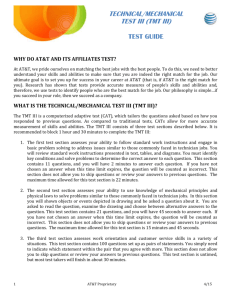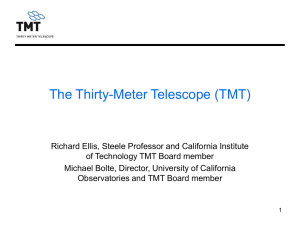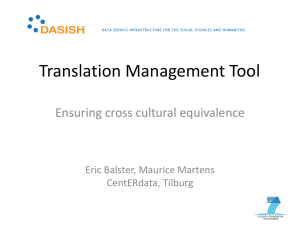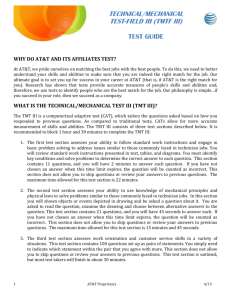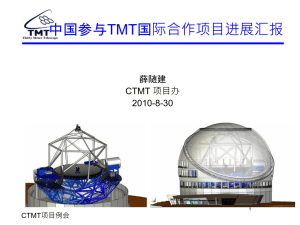Astronomy Technology Research Group, Review and Outlook
advertisement
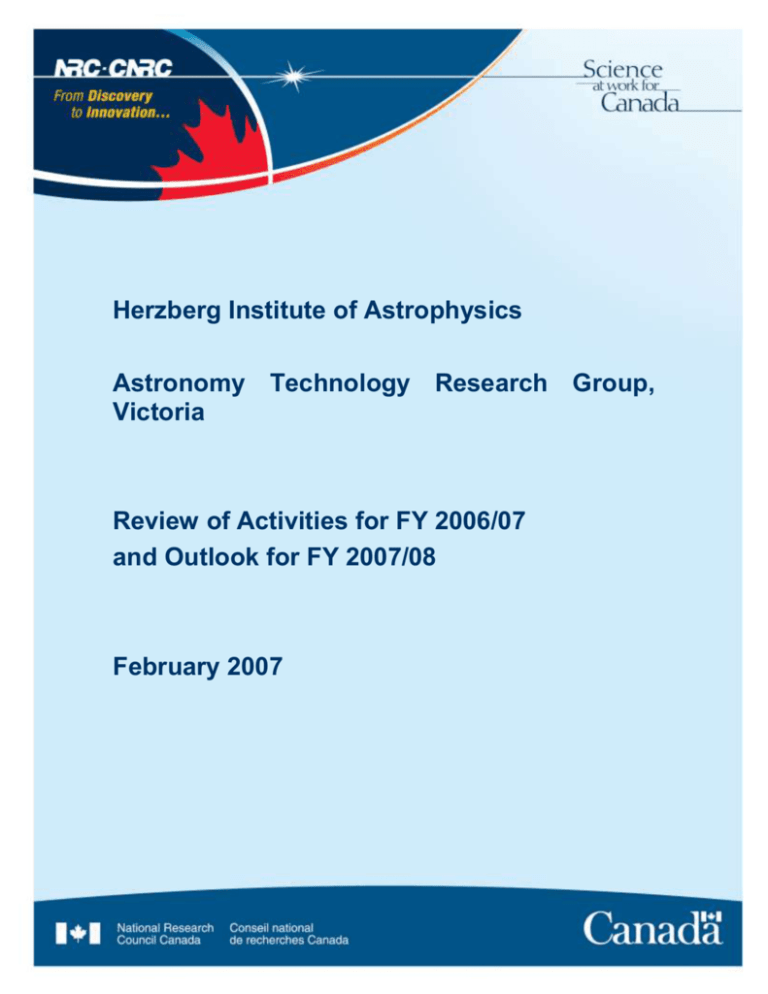
Herzberg Institute of Astrophysics Astronomy Technology Research Group, Victoria Review of Activities for FY 2006/07 and Outlook for FY 2007/08 February 2007 ASTRONOMY TECHNOLOGY RESEARCH GROUP – VICTORIA 1. Highlights ...........................................................................................................4 Group Leader .............................................................................................................................. 4 ALMA Band 3 ............................................................................................................................ 4 Gemini GPI Instrument ............................................................................................................... 4 TMT ............................................................................................................................................ 4 2. Major Projects ...................................................................................................5 ALMA Band 3 ............................................................................................................................ 5 Gemini Planet Imager (GPI) ....................................................................................................... 5 TMT Project Support .................................................................................................................. 5 TMT Narrow Field Infra-Red Adaptive Optics System (NFIRAOS) ........................................ 6 TMT Wide Field Optical Spectrograph (WFOS) ....................................................................... 6 3. Research Activities ............................................................................................7 Millimetre Instrumentation Research ......................................................................................... 7 Adaptive Optics Research ........................................................................................................... 7 Victoria Open Loop Testbed (VOLT) ........................................................................................ 7 TMT Analytical PSF Modeling .................................................................................................. 7 MEMS DM Controller ................................................................................................................ 7 4. Minor Projects ...................................................................................................8 CARMA Mixers.......................................................................................................................... 8 TMT Infrared Multi-Object Spectrograph (IRMOS) MOAO system ........................................ 8 Gemini FLAMINGOS-2 OIWFS ............................................................................................... 8 Gemini FLAMINGOS-2 Tunable Filters (F2T2) ....................................................................... 8 Gemini ALTAIR Laser Guide Star (LGS).................................................................................. 8 Gemini ALTAIR Field Lens ....................................................................................................... 8 High-speed Acquisition Camera (HIAC).................................................................................... 9 Inuksuk Arctic Site Testing ........................................................................................................ 9 MDA RapidEYE ......................................................................................................................... 9 James Webb Space Telescope FGS ............................................................................................ 9 Ultra-Violet Imaging Telescope (UVIT) .................................................................................... 9 5. Business Development and Partnerships ......................................................10 Business Development Activity................................................................................................ 10 Corporate Relationships ............................................................................................................ 10 6. University Collaborations ...............................................................................11 University of Victoria ............................................................................................................... 11 Camosun College ...................................................................................................................... 11 University of British Columbia................................................................................................. 11 Ecole Polytechnique de Montréal ............................................................................................. 11 Université de Montréal ............................................................................................................. 11 University of Toronto ............................................................................................................... 11 University of Florida ................................................................................................................. 11 University of Virginia ............................................................................................................... 12 Université de Nice (France) ...................................................................................................... 12 National Taiwan University ...................................................................................................... 12 7. Staff and Expertise ..........................................................................................13 8. Future Directions .............................................................................................16 Fostering Canadian University Instrumentation ....................................................................... 16 HIA ATRG-V Activity Summary FY 2006/2007 2 Fostering Canadian Industry ..................................................................................................... 16 Potential New Projects for 2007/08 .......................................................................................... 16 HIA ATRG-V Activity Summary FY 2006/2007 3 1. Highlights Group Leader In the last report, replacing the Group Leader was identified as a major issue. This has recently been resolved with the appointment of one of the senior engineers, David Loop, as Group Leader of the ATRGV, and the appointment of Luc Simard as a Science Officer in the ATRG-V. David Crampton also remains attached to the ATRG-V as Chief Science Officer. David Loop joined the ATRG-V in March 2005 as a Systems Engineer with an extensive record of technology contributions, mostly in electronics and radio frequency engineering across a broad range of technologies and industry sectors. He has contributed to virtually all of the major projects undertaken by the group, including; ALMA Band 3, F2T2, GPI, the TMT Enclosure, NFIRAOS, and WFOS. David also has extensive experience in the management of technical teams and it is already apparent that his expertise will enable the group to continue their leadership in astronomical technology. ALMA Band 3 The first preproduction Band 3 cartridge was delivered to the ALMA Front End Integration Center (FEIC) in Charlottesville VA in October 2006. The cartridge is fully functional and meets all the ALMA technical requirements. The ownership of the cartridge was transferred to NRAO in December 2006. The acceptance review of the second cartridge was held on January 18, 2007, and it has also been accepted by the ALMA Front End Integrated Project Team (FE IPT). It will be shipped to the FEIC in February 2007. The delivery of eight preproduction cartridges will be completed by December 2007. Technology transfer of the cryogenic low noise amplifiers (LNA) to Nanowave Technologies has been completed. A contract was awarded to Nanowave for the production of 300 LNAs for the Band 3 production cartridges. The commercialization of the LNA technology has been very successful. Since the granting of the license agreement to Nanowave in October 2005, two amplifiers were delivered to CEA Saclay (France), and in December 2006 Nanowave received a confirmed order from the Combined Array for Research in Millimeter-wave Astronomy (CARMA) to supply cryogenic IF amplifiers for their 100 GHz receivers. Gemini GPI Instrument The preliminary design of the Gemini Planet Imager (GPI) started in earnest in June 2006. This major Gemini Aspen instrument project is a collaboration between the ATRG-V, the Lawrence Livermore National Labs, the Center for Adaptive Optics at the University of California Santa Cruz, the University of California Los Angeles, the American Museum of Natural History, and NASA’s Jet Propulsion Laboratory, as well as researchers from Université de Montréal, University of California Berkeley, and INO. ATRG-V is responsible for the design of the opto-mechanical bench, the overall structure, Gemini interfaces and handling, the high level software, and is co-responsible for the real time control algorithms. This represents the largest work scope of all the partners. In January 2007, Les Saddlemyer from the ATRG-V has also been asked to assume the responsibility of Systems Engineer for the whole project. At the time of writing (January 2007), the project is proceeding very well, and is on track for its Preliminary Design Review scheduled in late May 2007. TMT ATRG-V designs and studies of NFIRAOS (Narrow Field Infrared AO system), WFOS (Wide Field Optical Spectrograph), and IRMOS (IR Multi-Object Spectrograph) all received excellent reviews by international experts during the TMT Conceptual Design Review. ATRG-V cost studies of NFIRAOS and WFOS also received excellent reviews during the TMT Cost Review, and the TMT Science Advisory Committee continues to rank NFIRAOS and WFOS highly in the first light instrument suite. HIA staff have been selected to play major leading roles in the TMT project: David Crampton continues as TMT Instrumentation Manager with assistance from Luc Simard, Kei Szeto was appointed TMT Telescope Structure group leader, and Scott Roberts was appointed TMT Deputy Systems Engineer. HIA ATRG-V Activity Summary FY 2006/2007 4 2. Major Projects ALMA Band 3 Project Manager: Keith Yeung Project Engineer: Stéphane Claude Work continues on the development of the Band 3 receivers, a critical element of the multi-national Atacama Large Millimeter Array (ALMA) Radio Telescope project. ATRG-V’s involvement will culminate with the delivery of 62 highly sensitive receivers to ALMA. In 2007, the ATRG-V will continue to fabricate Band 3 preproduction cartridges. The delivery of the eight preproduction cartridges is expected to be completed in December 2007. A manufacturing plan for the Band 3 production cartridges was developed in consultation with Canadian industry. According to this plan, a major portion of the production work will be outsourced to industry, including materials planning and procurement, fabrication of cryogenic low noise amplifiers, construction of mixer assemblies and SIS wafer qualifications, and mixer and cartridge testing. The first production contract was awarded to Nanowave Technologies for the production of 300 cryogenic LNAs. Several other industrial contracts for the mixer construction and wafer qualifications, and materials procurement will be issued in 2007. Gemini Planet Imager (GPI) Project Leader: Les Saddlemyer Project Co-P.I.: Jean Pierre Véran The preliminary design of the Gemini Planet Imager (GPI) started in earnest in June 2006. GPI is an extremely ambitious instrument aimed at imaging extra-solar planets (detection and characterization). It is made of four major sub-systems: a very high order (extreme) adaptive optics system, a coronagraph, an integral field spectrograph, and an interferometric calibration unit able to measure residual wave-front errors in the science band at sub-nanometer levels. This major project is a collaboration between the ATRG-V, the Lawrence Livermore National Labs, the Center for Adaptive Optics at the University of California Santa Cruz, the University of California Los Angeles, the American Museum of Natural History and NASA’s Jet Propulsion Laboratory, as well as researchers from Université de Montréal, University of California Berkeley, and INO. ATRG-V is responsible for the design of the opto-mechanical bench, the overall structure, Gemini interfaces and handling, the high level software, and is co-responsible for developing the real time control algorithms. This represents the largest work scope of all the partners. In January 2007, Les Saddlemyer from the ATRG-V has also been asked to assume the responsibility of Systems Engineer for the whole project. At the time of writing (January 2007), the project is proceeding very well, and is on track for its Preliminary Design Review scheduled in late May 2007. TMT Project Support Project Leader: Scott Roberts TMT Instrumentation Manager: David Crampton TMT Deputy System Engineer : Scott Roberts TMT Telescope Structure Manager: Kei Szeto All of the TMT instrumentation activity continues to be led by David Crampton, supported by Luc Simard and other members of the ATRG-V. Competitive feasibility studies of all of the planned TMT instruments were carried out and reviewed by international panels of experts in March 2006. Working with the TMT Science Advisory Committee (SAC), these were all synthesized and presented at the TMT Conceptual Design Review in May 2006, and detailed plans and costs for all instrumentation activity during both the construction and operations phases passed review in September 2006. Work is continuing on preparation of detailed systems engineering requirements and plans for the TMT Construction Proposal. ATRG-V has participated in TMT Systems Engineering tasks throughout the last year. After the cost review in September 2006, HIA took a leading role in re-scoping the observatory to meet the $700 M USD cost target. This effort focused on the enclosure, telescope structure, Nasmyth platforms and instrumentation layout. ATRG-V staff are now assisting with a variety of system engineering tasks in support of the upcoming construction review; optical modeling, analytical support, error budgets, and requirements. HIA ATRG-V Activity Summary FY 2006/2007 5 In November 2006, Scott Roberts took on the role of TMT Deputy Systems Engineer. This role involves developing system wide requirements for the observatory, and managing the development of the construction proposal review document by June 2007. Kei Szeto has been appointed to be the TMT Telescope Structure group leader by the TMT Project Office and given the responsibilities to lead the full range of engineering work, technical and management, for the telescope structure system during the design and development phase. This is a collaborative interface between AMEC Dynamic Structures and the TMT project in the form of the work package manager who defines the technical contents, schedule and budget of AMEC work on the telescope structure system. TMT Narrow Field Infra-Red Adaptive Optics System (NFIRAOS) Project leader: Glen Herriot HIA Project Scientist: Jean Pierre Véran The ATRG-V successfully completed a Conceptual Design Study and detailed costing for NFIRAOS, the facility adaptive optics system for TMT, which will feed up to three client astronomical instruments. The design study included opto-mechanical and operating concepts, together with detailed performance simulations, analyses and error budgets. The work was praised by international reviewers at the TMT instrument and AO review in March 2006, at the TMT Conceptual Design Review in May 2006, and at the TMT Cost Review in September 2006. It is anticipated that the NFIRAOS design work will recommence in 2007, led by the ATRG-V team. As well, the NFIRAOS team served on review committees for key TMT AO components such as tip-tilt platforms, and real time computers. The ATRG-V NFIRAOS team continues to work closely with the University of Victoria AO Laboratory in areas of adaptive optics control system modeling, table-top experiments, and evaluation of prototype components for NFIRAOS, such as deformable mirrors. TMT Wide Field Optical Spectrograph (WFOS) Project leader: Scott Roberts The ATRG-V, together with an international science team led by Roberto Abraham at the University of Toronto, completed a feasibility study of WFOS with a 4 barrel design that was able to meet all of the Science Requirements. Following a successful international review in March 2006, the design was featured again at the TMT Conceptual Design Review in May 2006, and a reduced (two barrel, mostly for reasons of cost) version was presented at the TMT Cost Review in September 2006. The TMT SAC has consistently recommended that WFOS is one of their highest priority instruments for TMT first light and so it is anticipated that the WFOS design work will recommence in 2007, led by the ATRG-V team. HIA ATRG-V Activity Summary FY 2006/2007 6 3. Research Activities Millimetre Instrumentation Research Project Leader: Stéphane Claude The ATRG-V Millimetre Instrumentation Team currently has three radio engineers, three technologists and three graduate students (two PhDs and one Master). The Band 3 project is the main activity of the team although a significant fraction of the their time is dedicated to research. The team continues to develop a concept for the Square Kilometer Array (SKA) high frequency receiver (20-30 GHz). This R&D work is presently carried out in collaboration with University of Victoria and École Polytechnique de Montréal professors. A planar antenna array prototype has been designed and is been fabricated at École Polytechnique de Montréal. Also, wide band and low loss transmission line for integrated receiver design in a focal plane array are currently being investigated. For the ALMA Band 1, low noise amplifier designs are been investigated (hybrid design or MMIC), and a test set for prototype amplifiers is currently being designed. Results of these research activities have been presented at major international conferences. Adaptive Optics Research Project Leader: Jean-Pierre Véran The ATRG-V Adaptive Optics Team currently has two post-docs, one PhD student (plus one who finished during the summer 2006) and one Master’s student. They spend a significant fraction of their time on research. Research activities support our current TMT and Gemini projects and include advanced modeling of the performance of AO system, development of advanced AO control algorithms, AO concept demonstration (see VOLT) as well as astronomy with adaptive optics. Results of these research activities have been presented in major international conferences and published in peer-review journals. Victoria Open Loop Testbed (VOLT) Project Leader: David Andersen ATRG-V, in collaboration with the University of Victoria AO Laboratory, is leading a research and development effort to demonstrate open loop adaptive optics on-sky in 2007. As identified in our team’s TMT IRMOS feasibility study, open loop adaptive optics, in which the turbulent wavefront is sensed and corrected without benefit of feedback, is the greatest risk in building a Multi-Object Adaptive Optics (MOAO) instrument. We will use VOLT to clearly identify potential limitations of open loop control and demonstrate its implementation first in the lab and then on the 48 inch DAO telescope, in the first half of 2007. Since the start date in late August 2006, we have completed simulations of the performance, finalized the optical design, and ordered and received almost all the required hardware. We have just begun testing the wavefront sensor cameras and deformable mirror. TMT Analytical PSF Modeling Project Leader: Laurent Jolissaint In support of the TMT Systems Engineering effort, the ATRG-V has developed a comprehensive Matlabbased analytical tool (called OPTICA) that computes the effects of errors on the primary, secondary and tertiary mirrors on the PSF delivered by TMT. These errors include both static and dynamic errors such as figuring and phasing errors of the segments. The resulting PSF can be computed with or without adaptive optics correction. While not as versatile as the traditional Monte-Carlo approach, the analytical method has been demonstrated to be much faster and just as accurate. OPTICA is thus ideal to carry out trade studies that require the exploration of large parameter spaces. MEMS DM Controller Project Leader: David Loop ATRG-V, in collaboration with the University of Victoria AO Laboratory, is developing a controller for a 1024 actuator MEMS deformable mirror. Previous MEMS controllers have suffered from long capacitive high voltage cable lengths, and a close-coupled electronics concept with fibre communications is being developed. HIA ATRG-V Activity Summary FY 2006/2007 7 4. Minor Projects CARMA Mixers Project Leader: Stéphane Claude The CARMA Telescope has approached the ATRG-V to provide 18 mixers for receiver upgrades. The mixers provided by the ATRG-V will increase the CARMA sensitivity by a factor two, placing this facility as one of the leading radio interferometers in the World. The contract has been signed and the delivery of the first of the 18 mixers is scheduled for February 2007, followed by a performance review. The last mixer will be delivered in December 2007. TMT Infrared Multi-Object Spectrograph (IRMOS) MOAO system Project Leader: David Andersen NRC-HIA, in collaboration with Steve Eikenberry’s team at the University of Florida, completed a feasibility study of IRMOS, one of the proposed instruments for TMT, in March 2006. IRMOS will not be a first light instrument on TMT, because it relies on emerging methods and technologies, such as open-loop adaptive optics (see VOLT project below) and MEMS deformable mirrors. However, the University of Florida/NRC-HIA IRMOS concept was favorably received and will likely receive future attention, as the risk associated with these novel methods and technologies is retired through proper R&D. Gemini FLAMINGOS-2 OIWFS Project Leader: Brian Leckie FLAMINGOS-2 is a collaboration with Steve Eikenberry’s team at the University of Florida. The ATRG-V portion was to build an On-Instrument Wave-Front Sensor (OIWFS) for installation on an infrared spectrograph being built by the University. The OIWFS is currently awaiting final testing with the main instrument at the University of Florida. Gemini FLAMINGOS-2 Tunable Filters (F2T2) Project leader: David Loop ATRG-V is collaborating with Roberto Abraham at the University of Toronto and ComDev in Ottawa to enhance the Flamingos-2 instrument with tunable etalon filters and enable the Gemini Genesis Survey (GGS), a planned search for first generation star-forming systems. HIA is providing systems engineering and integration consulting for the project. When commissioned, this relatively inexpensive upgrade will make it possible to search for very faint and distant star formation regions, possible contenders for “first light”. Gemini is now considering the possibility of upgrading the project to a deployable facility-class system. The etalons are in the final manufacturing stages at ComDev and integration with the Flamingos2 instrument will begin later this year. Gemini ALTAIR Laser Guide Star (LGS) Project leader: Glen Herriot The ATRG-V helped Gemini to successfully complete the commissioning of Altair LGS. Very good performance and reliable operation have been achieved. Altair LGS is currently undergoing systems verification with NIFS, the Near-Infrared Integral Field Spectrograph and is expected to be available for regular queue-observing very soon. Gemini ALTAIR Field Lens Project leader: Darren Erickson The ARTG-V completed the construction and delivery of the Altair Field Lens to the Gemini North observatory. The Field Lens was designed to enlarge the corrected field of view for Altair by a factor of 20 to 30 times. Improvements are seen as an increased Strehl ratio and reduction in the anisoplanatism of the system. This upgrade was accomplished with minimal changes to the existing facility. HIA ATRG-V Activity Summary FY 2006/2007 8 High-speed Acquisition Camera (HIAC) Project leader: Tim Hardy ATRG-V completed work on HIAC, a low-noise, high frame rate camera for the local DAO telescopes. HIA astronomer JJ Kavelaars and PhD student Steve Bickerton recently used the camera for an observing campaign searching for Kuiper Belt objects. Inuksuk Arctic Site Testing Project Leader and Project Scientist: Eric Steinbring Project Engineer: Brian Leckie Inuksuk is a robotic weather station and sky-monitoring system for characterizing potential observatory sites in the Canadian High Arctic. The goal is to test three mountains on Northern Ellesmere Island, Nunavut. Two of these received a station in 2006 in collaboration with Ray Carlberg and his students at the University of Toronto, and thanks to logistical support from Natural Resources Canada. A third station is under development for a higher site as a partnership between NRC-HIA, Environment Canada, and Defence Research and Development Canada. This would employ an advanced camera for viewing the whole sky which is being built at CTIO. This third station is planned to be deployed in the summer of 2007. MDA RapidEYE Project Leader: John Pazder ATRG-V continues its consulting relationship with McDonald Dettweiler and Associates (MDA) through providing expert optical consulting on the RapidEYE project. RapidEYE is a constellation of five small satellites being developed by German industry in cooperation with MDA. It will be used to provide highresolution multispectral imagery and GIS services to commercial clients. James Webb Space Telescope FGS Project Leader: John B. Hutchings, HIA Astronomer ATRG-V continues its support of the James Webb Space Telescope project through work on the Fine Guidance Sensor (FGS). The FGS project is being led by ComDev and is funded by contracts with the Canadian Space Agency. HIA is contributing by developing performance models for the instrument, doing independent optical analysis, and undertaking unique detector testing. Ultra-Violet Imaging Telescope (UVIT) Project Leader: John B. Hutchings, HIA Astronomer ATRG-V continues its support to Routes on the UVIT project. UVIT is an ultraviolet space telescope that will be launched on the Indian Space Research Organization’s AstroSAT mission. HIA ATRG-V Activity Summary FY 2006/2007 9 5. Business Development and Partnerships Business Development Activity Since the signing of the Low Noise Amplifier (LNA) license agreement between NRC-HIA and Nanowave Technologies Inc, two amplifiers were delivered to CEA Saclay (France) in December 2005, and Nanowave also received a confirmed order in December 2006 from the Combined Array for Research in Millimeter-wave Astronomy (CARMA) to supply cryogenic IF amplifiers for their 100 GHz receivers. Several other Astronomy Institutions including Academia Sinica Institute of Astronomy & Astrophysics (ASIAA) and the Arizona Radio Observatory (ARO) have also expressed a keen interest in these ATRG-V developed LNAs. Staff continue to work with Nanowave Technologies to find applications in nonastronomy related areas. ATRG-V consulted with Terra Remote Sensing Inc. to help debug their next generation LIDAR for highresolution 3D aerial surveying. Staff are currently investigating the possible commercial value of microwave circuit simulation to companies developing remote sensing applications. ATRG-V staff continue to seek out firms who may be potential software development partners for TMT. ATRG-V is actively pursuing the opportunities to commercialize our Integrated Modeling Toolset, which was developed for modeling telescope performance. Engineers continue to investigate its possible commercial applications in modeling the performance of simpler optical systems such as cameras. Corporate Relationships Part of the TMT Telescope Structure Group Leader’s responsibilities is to provide the managerial interface between AMEC Dynamic Structures (ADS) and the TMT project in the form of the work package manager who defines the technical contents, schedule and budget of ADS’ work on the telescope structure system. Although the work package is a formal contractual arrangement between TMT/ACURA and AMEC, the cooperation between TMT, ATRG-V, and AMEC is considered a partnership at many levels. The work package manager is an essential link to establish and maintain an amiable and effective long-term working relationship between the TMT and AMEC in addition to providing management oversight and engineering support to ensure the quality of the design work. Broadcast Live Technologies (BLT) Inc, a Victoria hi-tech startup company, is developing a light weight ear piece receiver that allows spectators of sporting events to listen to the play-by-play broadcast of the home team, of the opponent's team, or even eavesdropping on the communications between coaches and players. Fans equipped with a Sportsbug receiver would be able to tune in to the broadcast channel of their choice. Through the IRAP program, BLT asked HIA for some technical support to evaluate and characterize the antenna designs for the Sportsbug receiver. Using the RF test instrumentation and the engineering support provided by the ATRG-V, the work was completed in May 2006. BLT was able to evaluate the sensitivities of various antenna designs and select one best suited for their application. They finished the construction of their prototype units and hosted a product demonstration to launch the Sportsbug receiver in October 2006. ATRG-V is providing expertise and advice to COMDEV in support of their collaboration on the FGS and NIRCAM components of the JWST project, and on the Flamingos-2 tunable filter F2T2 development. ATRG-V has provided technical and strategic advice to Routes, Inc on an ultraviolet imager and identified and nurtured a flight opportunity on a satellite being built by the Indian Space Agency in Bangalore. ATRG-V maintained its relationship with INO of Saint Foy, Quebec through collaboration on the Gemini Planet Imager Project. INO’s optical expertise is showcased internationally through its involvement in collaborative astronomy projects. ATRG-V renewed its contract to provide expert consulting to McDonald Detweiller for its RapidEYE project. HIA and MDA continued to explore areas of mutual interest in satellite imaging and space technology. ATRG-V is collaborating with Flexmet Inc. to develop test equipment and facilities for adaptive optics. Flexmet Inc. is a privately held company with access to resources and material at the University of Victoria. HIA ATRG-V Activity Summary FY 2006/2007 10 6. University Collaborations University of Victoria ATRG-V is a collaborator with the University of Victoria’s ELIDA laboratory and provides expertise to the Adaptive Optics program, in addition to mentoring and assisting students. The ATRG-V is supervising and supporting the University of Victoria’s Segment Testbed which is exploring distributed control for highly segmented telescope mirrors. ATRG-V continues to collaborate with the Department of Electrical Engineering at the University of Victoria: ATRG-V provided support on software for simulating the detailed behaviour of microwave components to Dr W. R. Hoefer, leading to a Strategic Project Grant Final Report issued this year. The simulation (Hybrid field/SIS time domain model) of ALMA Band 3 mixer chip was done by a graduate student, who was co-supervised by Dr Hoefer and Stéphane Claude. Stéphane Claude and Dr Jens Bornemann are co-supervising a graduate student, Ian Wood, who will defend his Master in the fall of 2007. The research work focuses on the design of planar antenna for radio astronomy. A prototype is currently being fabricated by the laboratory of École Polytechnique de Montréal. David Crampton has renewed his appointment as an adjunct faculty at the University of Victoria; Stéphane Claude and Jean-Pierre Véran, and Luc Simard are also adjunct faculty. Camosun College André Anthony, Mechanical Designer, sits on the Mechanical Technologists Advisory board at Camosun College and acts as a sessional instructor. University of British Columbia ATRG-V collaborated with the University of British Columbia to evaluate the impact of the variability of the mesospheric sodium layer on laser guide star performance for TMT. The project scientist for NFIRAOS, Paul Hickson UBC, worked closely with the ATRG-V during the conceptual design phase. Ecole Polytechnique de Montréal ATRG-V continues to work with faculty and students of the advanced microwave research centre at the Ecole Polytechnique de Montréal. At least one doctoral dissertation directly beneficial to millimetre astronomy is expected to result, and further opportunities are being identified. The research work focuses on integrated receivers for planar array technology that can be used for radio telescopes. Université de Montréal The ATRG-V has established a subcontract in the Gemini Planet Imager (GPI) project with Rene Doyon at Université de Montréal to develop data reduction software, and is co-supervising a PhD student from Université de Montréal to work on advanced AO algorithm in support of the GPI project. University of Toronto ATRG-V is collaborating with Professors Ray Carlberg and Roberto Abraham of the University of Toronto, on various aspects of the TMT project and with Roberto Abraham on the F2T2 tunable filter project to search for first light objects with Gemini. University of Florida Our partnership with the University of Florida continued beyond the Flamingos-2 instrument. ATRG-V is now working with Professor Stephen Eikenberry of UF to incorporate tunable filters for the Flamingos-2 instrument. We are also closely collaborating on a design study for TMT’s IRMOS. HIA ATRG-V Activity Summary FY 2006/2007 11 University of Virginia ATRG-V continues to cooperate with the University of Virginia, as more wafers are being developed for the ALMA Band 3 project. Université de Nice (France) ATRG-V began mentoring a student from the University of Nice, France developing advanced background optimizing algorithms for NFIRAOS, to track wavefront sensor centroid gain in real time. National Taiwan University ATRG-V started a collaboration with the National Taiwan University (NTU), Department of Electrical Engineering in Taipei. NTU students are supported through an exchange program between NRC and the Taiwan Economic and Cultural Office (TECO) in Canada. A PhD student is currently working with Stéphane Claude and Frank Jiang of the ATRG-V on testing of MMIC (Monolithic Microwave Integrated Circuit) for the ALMA Band 1, and high frequency range of the SKA project. HIA ATRG-V Activity Summary FY 2006/2007 12 7. Staff and Expertise In last year’s report, replacing the Group Leader was identified as a major issue. A search was undertaken to find a direct replacement for David Crampton, focusing on astronomy scientists with instrumentation team leadership experience. This search was unsuccessful and alternative leadership models were then investigated. A composite leadership model was identified whereby an engineer could lead the group with support from an advisory team of astronomy scientists. This composite leadership model has been actualized by appointing one of the senior engineers, David Loop, as Group Leader, and appointing Luc Simard as a science advisor to the ATRG-V. David Crampton also remains attached to the group in a science advisory role. Science advisors from the millimetre and space astronomy groups within HIA will also be utilized. During the past year, two of our senior optical engineers, Chris Morbey and Jim Stilburn, retired and Murray Fletcher will also likely retire soon. Chris' design skills are being largely fulfilled by a new hire, Jenny Atwood, but Jim and Murray's hands-on knowledge and expertise needs to be replaced immediately. In the adaptive optics team, Laurent Jolissaint will leave at the end of February (for a senior AO position at Leiden) and Jeff Stoesz completed his PhD and is now doing a postdoc at Arcetri. Both of these contributed a lot to our AO program, especially to AO for TMT. We are in the process of recruiting an AO postdoc for the Gemini GPI project, but need to augment our general AO staff, particularly to support TMT-related projects (NFIRAOS). More specifically, we have an on-going requirement for another AO specialist, as well as another research associate with similar skills. In the mechanical team, Rusty Gardhouse left during the year, and Kei Szeto and Scott Roberts were committed to full time TMT support roles in telescope structure and systems engineering, respectively. These mechanical engineers need to be replaced in the coming year. In the software team, Les Saddlemyer has been committed to the Gemini GPI project in project management and systems engineering roles. We need to recruit a replacement software engineer/computer scientist for instrument control software in the coming year. In addition, we have need for another algorithm/mathematics specialist. In the electronics team, we anticipate the imminent retirement of Dennis Derdall, an electronics technician, and the retirement of Brian Leckie, the team leader, after the coming year. We need to evaluate our electronics staffing in the coming year and rebuild this team. Table 1 EMPLOYEES (2006/07) Count 1 2 3 4 5 6 7 8 9 10 11 12 13 14 15 Employee Skill Tenure Anthony Atwood Claude Crampton Derdall Dindo Duncan Dunn Erickson Fitzsimmons Fletcher Fotsy Ganton Hardy Herriot Mechanical Designer Optical Engineer Radio Engineer / MM Team Leader Astronomer Electronic Technician Radio Engineer Mechanical Designer Software Engineer / SW Team Leader Mechanical Engineer (Calgary) / ME Team Leader Mechanical Engineer Optical Engineer Administrative Assistant Mechanical Technician Electronic Engineer Systems Engineer Continuing Continuing Continuing Continuing Continuing Continuing Continuing Continuing Continuing Continuing Continuing Continuing Continuing Continuing Continuing HIA ATRG-V Activity Summary FY 2006/2007 End Date 13 16 17 18 19 20 21 22 23 24 25 26 27 28 29 30 31 32 33 Hnylycia Jennings Jiang Leckie Mirza Pazder Powell Ricard Roberts Rodrigues Saddlemyer Sebesta Simard Smith Szeto Véran Wooff Yeung Mechanical Technician Mechanical Tech. / Shop Sup. Radio Engineer Electronic Engineer / EE Team Leader Electronic Technician Optical Designer / Opt. Team Leader Optical Designer (1/2 time) Administrator, Project Support Mechanical Engineer (Vancouver) Electrical Technician Software Programmer Mechanical Designer Astronomer Software Programmer Mechanical Engineer AO Scientist / AO Team Leader Software Programmer Project Manager 34 35 36 37 38 39 40 41 42 43 44 Andersen Byrnes Caputa Garcia Hill, Alexis Jolissaint Loop Niranjanan Pfleger Steinbring Welle Adaptive Optics Scientist/Astronomer Mechanical Engineer Electronic Engineer Electronic Technician Mechanical Designer AO Scientist (Post-Doc) Group Leader Electronic Technician Electronic Technician Adaptive Optics Scientist (CGO) Mechanical Designer Murowinski Eisenhuth Ford Gardhouse Sun Stilburn Project Manager Mechanical Technician Administrator, Project Support Mechanical Engineer Mechanical Engineer Optical Engineer HIA ATRG-V Activity Summary FY 2006/2007 On Leave On Call Off Staff Off Staff Off Staff Retired 14 We have a strong contingent of students and visiting workers continuing into the coming year and we will recruit to maintain the current level. Table 2 STUDENTS/VISITING WORKERS (2006/07) Count 1 2 3 4 5 6 7 8 9 10 11 12 13 14 15 16 Name Bandara Butler Dionne Dousset Feige Fischer Fraser Huang Kerley Lavigne MacPhee, Michelle Nataf, David Stoesz Thanjavur Wang Wood Program / Institution MSc/Visiting worker, Uvic Co-op, UVic WES, Sherbrooke Ph.D/Visiting Worker, Ecole Polytechnique de Montréal Ph.D/Visiting Worker Tenure Active Complete Complete Visiting Worker PhD., UVic PhD/Visiting worker, National Taiwan U. Morton Fellowship, Uvic Ph.D/Visiting Worker, U. Laval Active Complete Active Active Active Active Active Co-op, UPEI Co-op, McGill Ph.D, UVic PhD/Visiting Worker, UVic Co-op, UBC MSc/Visiting worker, UVic Complete Complete Complete Active Complete Active HIA ATRG-V Activity Summary FY 2006/2007 End Date 15 8. Future Directions The ATRG-V will continue to pursue its vision of being the world’s foremost astronomy technology group, focused primarily on the development of instrumentation. We believe that, by doing so, we can not only fulfill our mandate to support Canadian astronomical facilities, but also participate in creating technologies that can facilitate groundbreaking scientific achievements for Canadian scientists. To maximize the gains we can make in science and technology, we plan to: Continue to recruit world-class staff and students, especially in key and emerging areas such as adaptive optics, receiver and detector technologies, and control systems. Invest sufficient financial resources in equipment and platform technologies in our key areas (adaptive optics, millimetre research, optomechanics, cryogenics, software/simulation, electronics, and high-precision machining) to keep our expertise competitive in the world arena. Maintain a sufficient resource base to allow our staff to pursue forward-looking R&D. Fostering Canadian University Instrumentation We will undertake an outreach program to Canadian university astronomy instrumentation groups to exchange ideas on current and future Canadian astronomy instrumentation initiatives. The goal will be to establish a small number of instrumentation collaborations to stimulate the growth of astronomy instrumentation skills and to establish an ongoing rapport and an improved network of astronomy instrumentation capability. Fostering Canadian Industry We will also undertake an outreach program to Canadian researchers in industry and non-astronomy university technology faculties and associated incubator enterprises. We will exchange ideas on technologies, presenting our current views on astronomy technology needs and opportunities, and the researchers presenting their latest work. The goal will be to establish a small number of research collaborations to stimulate the development of new Canadian astronomy technologies, and to position Canadian industry and researchers to partake in future astronomy instrumentation projects. Potential New Projects for 2007/08 In addition to continued effort on our major project and research efforts discussed above we have potential for the following additional projects, Gemini GLAO: ATRG-V is well placed to lead the Gemini Ground Layer Adaptive Optics (GLAO) project if this project starts at the end of the Mauna Kea site characterization campaign. We anticipate being involved in the modeling activities in the coming year Focal Plane Array K Band Camera: The Canadian Radio Astronomy community has expressed an interest in a focal plane array K Band (17 to 30 GHz) camera to be commissioned on the GBT as a visiting instrument. It has been suggested that the ATRG-V may be able to contribute through system design and also by providing the 26 GHz LNAs in collaboration with a Canadian university team. VLT Adaptive Optics: We will likely be asked to submit a proposal for the construction of a number of small adaptive optics systems for the VLT interferometer project. This is a testament to our stature in the world AO community and may be an attractive revenue project opportunity. HIA ATRG-V Activity Summary FY 2006/2007 16
